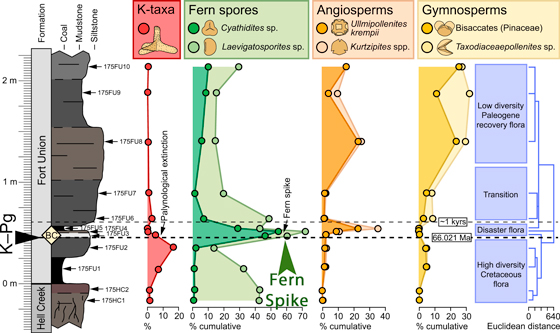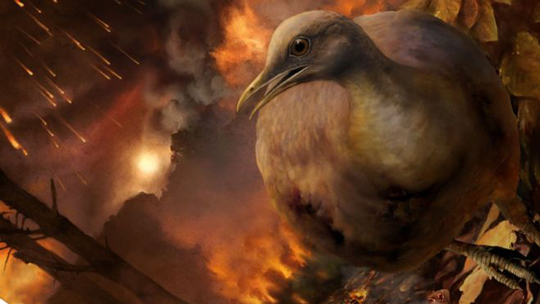How Birds Survived the Cretaceous Mass Extinction Event
Ground Dwelling Birds Survived Asteroid Strike
One of the fascinating conundrums about the end Cretaceous extinction event is how did the avian dinosaurs (birds) survive, but their very close cousins the non-avian dinosaurs, animals such as Tyrannosaurus rex, Triceratops and Edmontosaurus fail to make it through this calamitous time in Earth’s history? A team of international researchers, writing in the journal “Current Biology” have put together a fascinating explanation as to why we have birds today, but no other theropods, or indeed any other representatives of the Dinosauria.
With the extra-terrestrial impact event some 66 million and 38 thousand years ago (plus or minus 11,000 years), the ecosystems on our planet were devastated. Whether this single, huge impact was the sole cause of the mass extinction or whether this was the final “coup de grâce” is debatable, however, life would never be the same again.
Using a variety of data sources, the team, which included scientists from the University of Bath, the Denver Museum of Nature and Science, Yale University and the Field Museum amongst others, have pieced together what the impact event meant for the Aves. Their scientific paper suggests that the only kinds of birds to survive the Cretaceous-Palaeogene (K-Pg) extinction were ground- dwellers.
How Our Feathered Friends Survived the Cretaceous-Palaeogene Extinction Event
Picture credit: Phillip Krzeminski
Why Did the Birds Survive?
A number of ideas and theories have been proposed to help explain why the birds are around today, but the non-avian dinosaurs are not. Recently, Everything Dinosaur published an article on a piece of research that suggested that seed-eating may have contributed to the survival of birds during this devastating time in the history of our planet.
To read the article: Seed Eating May Have Helped the Birds Survive.
Commenting on the scientific paper, lead author Daniel Field of the Milner Centre for Evolution (University of Bath) stated:
“We drew on a variety of approaches to stitch this story together. We concluded that the devastation of forests in the aftermath of the asteroid impact explains why tree-dwelling birds failed to survive across this extinction event. The ancestors of modern tree-dwelling birds did not move into the trees until forests had recovered from the extinction-causing asteroid.”
The Collapse of Forests
The scientists analysed the plant fossil record and identified that the world’s woodlands and forests were virtually wiped out by the extra-terrestrial impact. Huge forest fires would have raged in the immediate aftermath of the impact and it is likely that much of the world had to endure a period of extensive “acid rain” as a result of the catastrophic event. In the months, or maybe even tens of years afterwards, our planet could have been blanketed in a cloud of dust and ash. This would have blocked out the sun and led to the collapse of food chains which relied on photosynthesising plants.
The scientists look at the record of fossil pollen and spores to assess the types of flora present and how quickly, ferns, flowering plants (angiosperms) and other types of flora recovered after the extinction event.
Plotting the Turnover of Different Types of Flora from Pollen and Spore Counts

Picture credit: Current Biology with additional annotation by Everything Dinosaur.
The diagram (above), plots the palynological record of the John’s Nose Section in North Dakota, a series of sequential strata laid down before, during and after the extinction event. It helps to plot the demise of different types of plant and their recovery (floral turnover), as evidenced by changes in relative abundance of common pollen taxa across the K-Pg boundary. Note, the “fern spike” recorded not long after the extinction event, ferns are usually the first type of plant to recover from natural disasters today, as evidenced by their ability to re-populate areas destroyed following volcanic activity.
Evolutionary Relationships of Living Birds
The research team examined the evolutionary relationships of extant birds and their ecological habits to map how bird ecology has changed over time. The data revealed that the most common ancestor of all living birds, all the bird lineages that survived the K-Pg extinction event, most likely were ground-dwellers. In contrast, many Aves that lived at the end of the age of dinosaurs (and there were lots of them), exhibited tree-dwelling, arboreal habits. These species did not survive the mass extinction event and therefore they have no direct living descendants around today.
Daniel Field added:
“Today, birds are the most diverse and globally widespread group of terrestrial vertebrates, there are nearly 11,000 living species. Only a handful of ancestral bird lineages succeeded in surviving the K-PG mass extinction event 66 million years ago and all of today’s amazing living bird diversity can be traced to these ancient survivors.”
The researchers conclude that their findings shed light on the fundamental influence major events in the history of our planet have on the evolution of living things. The team hope to build on this initial research and to explore the timing of the recovery of the vegetation and to develop a better understanding of the early radiation of the birds. After all, those lucky survivors inherited a brave new world, devoid of non-avian dinosaurs and many other terrestrial and marine organisms too.
The scientific paper: “Early Evolution of Modern Birds Structured by Global Forest Collapse at the End-Cretaceous Mass Extinction” by Daniel J. Field, Antoine Bercovici, Jacob S. Berv, Regan Dunn, David E. Fastovsky, Tyler R. Lyson, Vivi Vajda and Jacques A. Gauthier published in the journal Current Biology.
Visit the Everything Dinosaur website: Everything Dinosaur.


